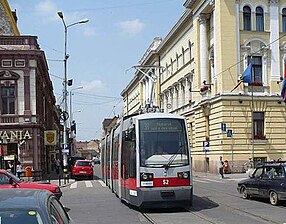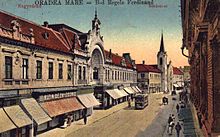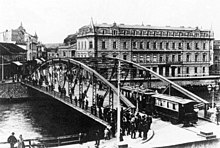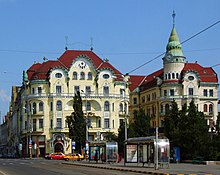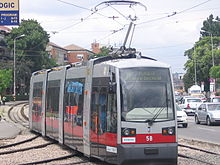Oradea tram
| Oradea tram | |
|---|---|
| Siemens ULF tram in the city center | |
| Basic information | |
| Country | Romania |
| city | Oradea |
| opening | August 28, 1882 (freight traffic) June 28, 1896 (passenger traffic) |
| electrification | April 25, 1906 |
| operator | OTL |
| Infrastructure | |
| Route length | 19.2 km |
| Gauge | 1435 mm ( standard gauge ) |
| Power system | 600 volt DC overhead line |
| Operating mode | Furnishing operation |
| Stops | 37 |
| Depots | 1 |
| business | |
| Lines | 3 |
| statistics | |
| Residents in the catchment area |
240 thousand |
| Network plan | |
The Oradea tram is one of the oldest tram systems in what is now Romania . The tram went into operation on August 28, 1882 in the western Romanian city of Oradea (Eng .: Großwardein ), which was then called Nagyvárad and belonged to Austria-Hungary . Today the tram is operated by the Oradea Transport Local RA (OTL). The Oradea tram was the first in Romania to use modern low-floor trams ; these are ULF- type cars manufactured by Siemens , identical to the vehicles used in Vienna . The tram network today includes lines 1R, 1N, 2, 3R and 3N.
history
Freight transport as a forerunner
Nucleus of the future tram Oradea was emanating from the Ostbahnhof in the district Velenta and with steam locomotives operated freight tram . Freight wagons of the Hungarian state railway Magyar Államvasutak (MÁV) were delivered or picked up on private sidings of various companies via this industrial main track , which opened on August 28, 1882 . The responsible operator, a joint stock company , was initially called Nagyváradi Gőzmozdonyú Közúti Vaspálya . In later years there were up to 27 connections that were served by the tram company's electric locomotives after the introduction of the electric tram . This operation only ended in 1994.
Steam tram
From June 28, 1896, steam-powered passenger trains finally ran on the previous freight tracks. This steam tram connected the Ostbahnhof with the church square in the city center, today Piața Unirii or Primărie stop. Steam operation ended with electrification. In total, the company acquired eleven steam locomotives over the years.
Electrification planning
In the autumn of 1897, two companies applied to plan and build an electric tram network in what was then Nagyvárad, making it one of the first cities in Transylvania to have electric trams. The two competing companies were the existing Nagyváradi Gőzmozdonyú Közúti Vaspálya and the Budapest joint stock company for electrical and transport companies (Hungarian Electric Works Trust). On December 25, 1897, the Nagyvárad City Council commissioned these companies to submit a definitive offer by January 8, 1898. By the deadline, only the offer from the local company had been received. The offer from the Hungarian Electrical Works Trust followed on January 13th. In October 1898 this offer was accepted as the conditions for the city were much better. However, in December 1898 the Ministry of the Interior canceled the award by the city council and awarded the concession to Nagyváradi Gőzmozdonyú Közúti Vaspálya .
Important provisions of the concession agreement
-
The city grants the company the right to carry out the work necessary for the construction of routes and their operation on the following roads, squares and bridges:
- from the main station via the main street (today: Strada Republicii), Bémer-Platz (today: Piața Regele Ferdinand), the small bridge, Kleiner Platz (today: Piața Unirii), Gartenstraße (today: Strada Avram Iancu) to the forecourt of the restaurant in the Rhédey -Garden (today: Parcul Nicolae Bălcescu);
- Branch from Small Square, via Graf Pál Teleki Street (today: Strada Primăriei) and on to the new wall of the cavalry barracks.
- from Small Square via Lajos Kossuth Street (today: Strada Independenței), Kolozsvár Street to the Church Square, then further along Kolozsvár Street to the railway line and the station building of the Velența district (the first important industrial area of the city).
- In view of the fact that the railway line between the church square and Velența train station already exists, based on the concession that the company held until August 28, 1932, it undertakes to electrify it. From this point on, the company undertakes to pay the city a rent of 10,000 forints .
- The client is obliged to carry out the construction work within eight months of receiving the building permit from the Ministry of Commerce (with the exception of November, December, January and February).
- With government approval, the company will have the right to build additional routes. If another company wants to build longer routes, the consent of both contracting parties is required. As soon as a net profit of six percent is achieved in three consecutive years, the builder is obliged to expand his network by three kilometers at the request of the city administration and in agreement with the Ministry of Commerce. This provision will remain in force until a total length of 25 kilometers of trams is reached.
Delays
In the summer of 1899, the approval of the Budapest Ministry of Commerce was still pending. The newspaper of the city on the bank of the Sebes-Körös "Nagyvárad" of September 14th reports in a short article with bitterness that Nagyvárad is a city of constant delays, where the motto of the city administration is: "What you can get today, postpone it see you tomorrow ”, and that in the case of the tram the ministry also accepted this motto. In the same month the Minister of Commerce made a brief visit to Nagyvárad, the reason for which is unknown. On this occasion he repeated his promises and made an undertaking to the mayor to fulfill the Nagyváraders' great wish as soon as possible.
The city council drafted a petition to expedite approval of the January 31, 1899 motion. This submission was motivated by the fact that the paving of the main road was damaged and could only be replaced after the rails had been installed. The situation was similar in front of the Finance Palace (today: Polyclinic No. 2) and on Bémer Square (today: Piața Regele Ferdinand), where the decision was made to build new streets and widen the old ones. In December 1899, the company Kappel und Fischer applied to the city administration for a concession to operate a bus . It was justified in the delays in the construction of the tram lines. The applicants argued that gasoline was cheaper than electricity, so it was more profitable to run. The four proposed lines were similar to the tram routes. The fare should be between four and ten fillers , and the operating time should range from 3:00 a.m. to 11:00 p.m. If this offer had been accepted, Nagyvárad would have been the first city in Transylvania with bus and coach transport. In contrast, horse busses have been part of the cityscape in Oradea since 1868.
On December 27, 1899, the ministry received a negative decision and the tram electrification project had to be rewritten and redesigned. A dark period followed with heated discussions for the project until 1905. Many times the project was on the verge of being abandoned until the groundbreaking ceremony for electrification took place on July 11, 1905. Also in 1905 the Nagyváradi Gőzmozdonyú Közúti Vaspálya was renamed Nagyváradi Városi Vasút ( NVV ).
Construction work
In the course of the electrification construction work, discussions arose about the origin of the construction workers, whether they were citizens of Nagyvárad or not, and riots broke out, but these were amicably settled. At the end of the month we worked with all our might. At the beginning of August, the laying of the tracks began on Theaterplatz together with the paving work under the direction of the engineer Henrik Reichel. At the beginning of November 1905, work was in full swing, so that the engineer Reichel ordered twelve electric railcars from the Győr wagon factory . At the same time, the proposals for the location of the stops were presented to the Ministry of Commerce:
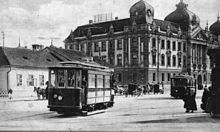
Stops on the main street (today: Strada Republicii)
- Central Station
- Military headquarters (intersection of Strada Republicii with Strada Pescărușului)
- Big hospital
- Sal Ferenc Street (today: Strada Dunărea)
- Úri Street (today: Strada Roman Ciorogariu)
- Bémer Square (today: Piața Regele Ferdinand)
- Small place
Stops on Kossuth-Lajos-Straße (today: Strada Independenței)
- Great synagogue
- Market hall (today: Oradea University Medical Faculty)
- Toma Street (today: Strada Cele Trei Crișuri)
- Distance signal (?)
- Velence train station
Stops on Gartenstraße (today: Strada Avram Iancu)
- Chamber of Crafts
- Diana bath (junction of Strada Avram Iancu and Strada Sucevei)
- Cadet School
- Rhédey garden (zoological garden)
Stops on Teleki Street (today: Strada Primăriei)
- Crossing Kalvin Street
- Junction of today's Strada Tuberozelor
- barracks
- Final destination (?)
| Main train station ↔ Velence train station | |||||||||||||||||||||||||||||||||||||||||||||||||||||||||||||||||||||||||
|---|---|---|---|---|---|---|---|---|---|---|---|---|---|---|---|---|---|---|---|---|---|---|---|---|---|---|---|---|---|---|---|---|---|---|---|---|---|---|---|---|---|---|---|---|---|---|---|---|---|---|---|---|---|---|---|---|---|---|---|---|---|---|---|---|---|---|---|---|---|---|---|---|---|
|
|||||||||||||||||||||||||||||||||||||||||||||||||||||||||||||||||||||||||
| Kleiner Platz ↔ Teleki Street | |||||||||||||||||||||||||
|---|---|---|---|---|---|---|---|---|---|---|---|---|---|---|---|---|---|---|---|---|---|---|---|---|---|
|
|||||||||||||||||||||||||
| Small square ↔ Rhédey garden | |||||||||||||||||
|---|---|---|---|---|---|---|---|---|---|---|---|---|---|---|---|---|---|
|
|||||||||||||||||
On November 30, 1905, Siemens-Schuckertwerke announced the completion of the track construction. The catenary masts had to be installed in the next construction phase. They were made of iron and artistically designed. In January 1906 the hiring of the drivers was completed. Due to the high demand for jobs, a sign on the temporary headquarters of the tram company (on Zöldfa útca, today: Strada Arborele Verde) announced that applications for jobs were no longer being accepted. In the following two months, the level of the fare was discussed without reaching a consensus. On the evening of March 1, 1906 from 8 p.m., the first test run of a tram took place on the main street and Kossuth-Lajos-Straße. The citizens of the city came together on the streets and escorted the train, which was guarded by police officers.
On March 3, 1906, the Electric Trams Operating Rules were published, drafted by the city's chief of police and approved by the city council. The test drives were continued on the following nights and from March 6th they also took place during the day. The Nagyvárad newspaper devoted an important place to this topic on the front page. Under the heading Tram on Main Street , the article began as follows:
"A great miracle happened, incredibly sensational, that got the blood of the calm Nagyváraders going."
completion
On March 16, 1906, the routes and stops of the tram line were announced and posted at the most important points in the city.
The trains ran every ten minutes. The fare was set as follows:
- A trip between the two stations or from each stop to one of the stations cost 20 fillers.
- Ten fillers were calculated for all other relations.
Technical specifications
At the end of the first year of operation of the Nagyvárad tram, the length of the electrified route network was 20 kilometers. It was served by 14 cars. The new overhead line network was supplied with a direct voltage of 550 volts. At the beginning of 1906, it was decided to put two generators into operation in the power station. Each generator was operated at a rotational frequency of 415 revolutions per minute and produced a current of 220 amperes.
The first 14 electric tram cars were manufactured by Magyar Waggon-és Gépgyár (MWG) in Győr , the electrical equipment was supplied by Siemens-Schuckertwerke . They had two engines with an output of 18 kilowatts at 550 volts and had a mass of 9.9 tons. Each car had a capacity of 20 seats and 19 standing places. In addition to the trams, two electric locomotives were also purchased, each with two electric motors with an output of 33 kilowatts. In addition to the new acquisitions, the Grosswardeiner Stadtbahn Actiengesellschaft owned two steam locomotives and four flat cars for freight transport.
In addition, a loner was in use in Nagyvárad, which had been built for the World Exhibition in Paris in 1900 . This car came from the same manufacturer, was labeled " TVVV 8" and was originally intended for use on the Timișoara tram . It finally came to Oradea, where it - retrofitted with magnetic brakes - was used as a sidecar with the number 51 from 1907 . Another sidecar came directly from Timisoara to Oradea, but it did not have a company number. This is a Spiering car from 1869 , which the TVVV used as a trailer of the electric vehicle as early as 1899.
opening
At the beginning of April 1906 everything seemed to point to an imminent official opening, but a new conflict over fares led to a further delay. Finally, on Saturday April 21, the city council decided that the opening should take place on April 25, 1906. On April 23, the city council decided that tickets that had been printed six weeks ago could be used. The opening banquet took place with more than 200 people in the Pannonia restaurant (today: Transilvania). Mayor Károly Rimler gave the opening speech.
“... and this morning - it will be good to note this date in particular: April 25, 1906 - the Großwardeiner tram started. In other provincial cities, such an event would be a miracle of miracles, but here, where the pace of development is advancing in leaps and bounds, Greater Oradin has long been prepared for it. Now, when the wonderful trams plow through the streets like lightning, the question arises: How could one imagine Greater Oradea, this powerful cultural center, without an electric tram? "
More than 5100 tickets were sold on the first day of operation. After a week everyone agreed that the Nagyvárad tram was a success. Small accidents in the early days cast a shadow over this great event. The accidents were caused by inattentive coach drivers who had not been given sufficient instruction on how to drive next to trams, or were caused by crowds.
Development until today
The network was constantly being expanded; in the 1950s there were up to eleven lines in service. Compared to the present day, more routes ran directly through the city center, i.e. within the tram ring. Around 1960, many lines began to be closed, while until the end of the communist era in 1989/90 only the lines to the industrial area west of the city and the extension to the end point of today's line 2, Ioșia , were added. The last line was closed in 1994 on the section from the city center to the Ostbahnhof, but the restoration is planned.
Today's line network
The Oradea tram network now has a total length of 19.21 kilometers. The track length is 37.14 kilometers. A total of 36 stops are served. Most of the stops have a shelter, the OTL has recently succeeded in modernizing them. The entire project comprised the modernization of 24 bus shelters within six years. It is planned to equip these shelters with dynamic passenger information . 24 stops are currently being equipped with it. Traffic management takes place via two control centers.
The core of today's tram network is a ring route around the city center, which the lines drive on and leave at three branches. Each direction of travel is marked as a special feature with a red line number, i.e. lines with the additional letter R for roșu (red) drive the entire ring counterclockwise , while those with N for negru (black) drive clockwise. Line 2 in turn only serves a short section of the ring route.
Line 1N: (Sinteza →) Pod CFR → Central Station → Piaţa Unirii → Pod CFR (→ Sinteza)
| Line 1 black (1N) | |
|---|---|
|
|
This line gives residents of the Rogerius district easy access to the city center, where it runs clockwise on a loop around the city center and offers transfer options to lines 2 and 3. With the exception of the rush hour from 8:30 a.m. to 1 p.m. and from 5 p.m. to 11 p.m., line 1N only runs as far as the railway bridge (Pod CFR), where passengers have to change to line 1NS, which runs every 20 minutes, to continue to Sinteza wrong. The time for one revolution is about 62 minutes. The length of the line is 16.143 kilometers.
Line 1R: Pod CFR → Piaţa Unirii → Central Station → Pod CFR
| Line 1 red (1R) | |
|---|---|
|
|
Line 1R runs on the same route as line 1N, but travels the loop around the city center in the opposite direction (counterclockwise).
Line 2: Nufărul ↔ Piaţa Unirii ↔ Ioşia
| Line 2 | |
|---|---|
|
|
This line opens up the districts of Ioșia and Nufărul and connects them with the city center, where it shares a section with the other two lines. The travel time for a complete circuit is around 60 minutes. The length of the route is 14.457 kilometers.
Line 3N: Nufărul → Piaţa Unirii → Central Railway Station → Nufărul
| Line 3 black (3N) | |
|---|---|
|
|
This line serves the same route as Line 2 between the Nufărul district and the city center, but ends in the inner city loop, which it travels clockwise. The travel time for one circuit is around 55 minutes. The length of the route is 13.764 kilometers.
Line 3R: Nufărul → Central Station → Piaţa Unirii → Nufărul
| Line 3 red (3R) | |
|---|---|
|
|
Line 3R runs on the same route as line 3N, but travels the loop around the city center in the opposite direction, i.e. counterclockwise.

vehicles
Oradea was the first city in Romania to use modern low-floor trams. In 2008/09, ten Siemens ULF vehicles were purchased. The tram fleet is supplemented by Tatra cars bought second-hand from Germany. They replaced the worn-out wagons from the socialist era, especially the Timiș 2 open-plan trains . Before that, four-axle trams of the V54 series from Electroputere and various two- axle trams , including the V58 produced by the main workshop of the Bucharest tram , operated . In addition, nine articulated cars of the types V2A and V3A , which were passed on to the Iași tram in the early 1990s .
literature
- Liviu Borcea, Mihai Apan and Gabriel Moisa: De la o stație la alta , Editura Arca, Oradea 2006
- Marius Moș: Un secol cu tramvaiul electric, Realitatea bihoreană , April 27, 2006
Web links
- Operator's website OTL (Romanian, Hungarian, English)
- (accessed on August 21, 2010). Photo gallery (German).
- (accessed on August 21, 2010). Photos from the 1970s (Romanian).
- (accessed December 29, 2012). Private page about the history of the tram with pictures (approx.).
Individual evidence
- ↑ Oradea Transport local RA prezentare activitate și analize economice perioda January 2008 – noiembrie 2009 on www.oradea.ro
- ↑ Iparvágány térképe on tramclub.org
- ↑ Trams & Tramways in Romania at www.beyondtheforest.com
- ↑ Csuzi István: The TRAMS, the base of PT in Oradea ( Memento of the original from July 14, 2014 in the Internet Archive ) Info: The archive link was inserted automatically and has not yet been checked. Please check the original and archive link according to the instructions and then remove this notice.
- ↑ Vehicle overview of the Oradea tram on www.pospichal.net ( Memento of the original from October 19, 2014 in the Internet Archive ) Info: The archive link was inserted automatically and has not yet been checked. Please check the original and archive link according to the instructions and then remove this notice.
- ↑ Borcea, p. 28
- ↑ Borcea, p. 35
- ↑ Borcea, p. 40
- ↑ Borcea, p. 41
- ↑ Borcea, p. 50
- ↑ Borcea, p. 55
- ↑ Borcea, p. 61
- ↑ Borcea, p. 70
- ↑ Marius Moş: Un Secol cu tramvaiul electric ( Memento of 7 May 2006 at the Internet Archive ), bihoreană Realitatea , April 27, 2006
- ↑ http://www.eminescu.rdsor.ro ( Memento of the original from September 28, 2013 in the Internet Archive ) Info: The archive link was inserted automatically and has not yet been checked. Please check the original and archive link according to the instructions and then remove this notice.
- ↑ Borcea, p. 71
- ↑ Borcea, p. 72
- ↑ RAOTL website
- ↑ RAOTL website
- ↑ RAOTL website
- ↑ RAOTL website
- ↑ RAOTL website

